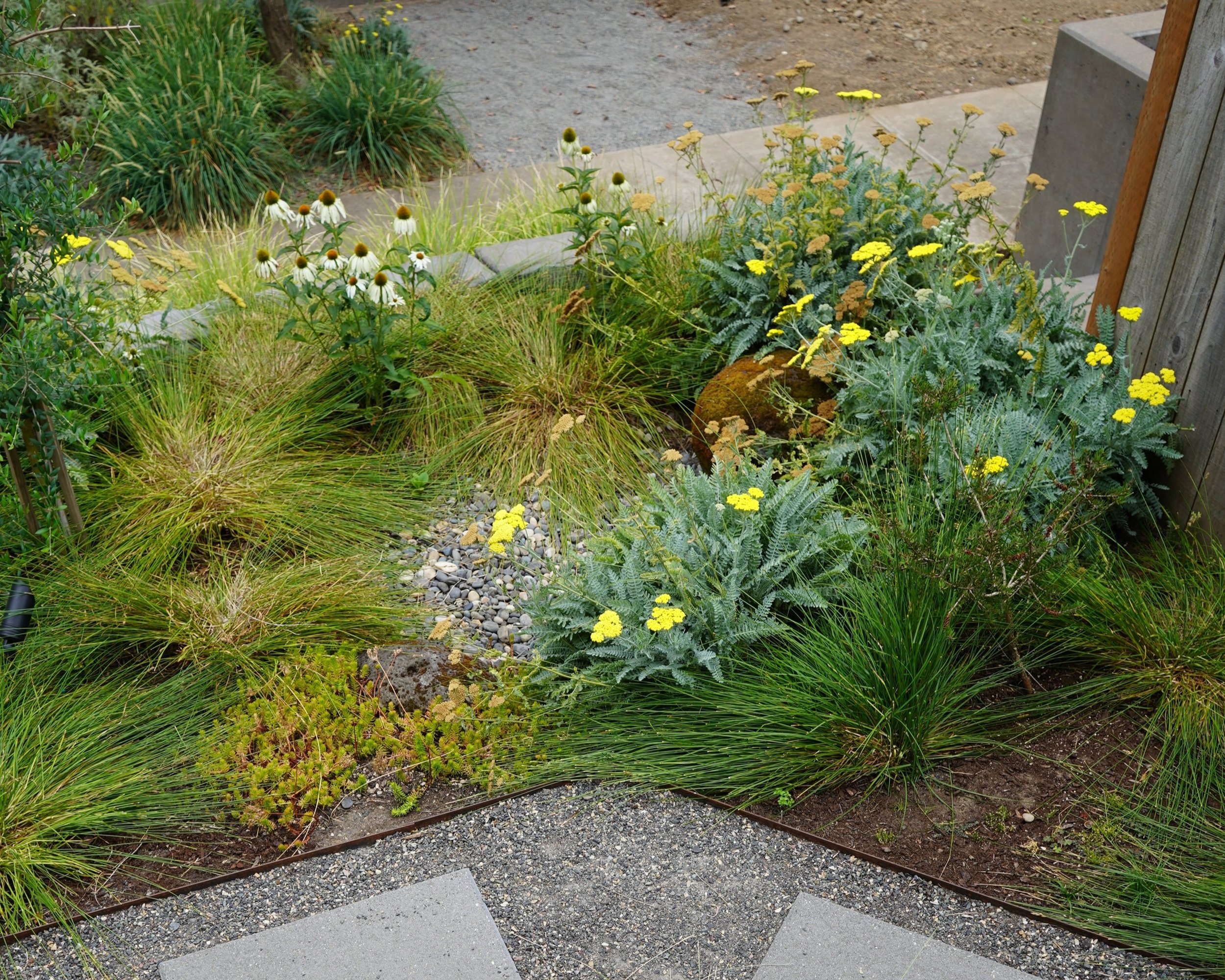Create a Thriving Garden
Create a thriving garden that lasts for years
Have you ever looked out your window and thought, I’d love to design and build a garden, but felt unsure where to begin?
You’re not alone! Creating a thriving garden can feel overwhelming, but with the right approach, it’s easier than you think.
In this post, we'll guide you through the essential components to designing a sustainable, well-draining landscape starting with the foundational elements that set you up for success. We'll show you how to analyze your yard's natural water flow, identify sunny and shaded areas, and assess your soil's health. From there, we'll explore selecting the right plants and creating a maintenance plan to keep your landscape thriving. And if terms like drainage patterns and soil amendments feel overwhelming, no problem! We'll also share how expert landscape designers can take care of the details for you.
Step 1: Assess Your Space
Start by understanding the unique characteristics of your yard. Take note of factors like sunlight exposure, the health of existing plants, drainage patterns, and landscape slope. This will help you plan for plants that will thrive in your specific conditions and identify any changes needed for stormwater management and grading. Spending time in your space throughout different seasons is a great way to observe these changes, but you can also use helpful resources like shademap.app to track sun exposure throughout the year.
In the "before" image, you can see a pipe protruding from a stacked rock retaining wall, directing excess stormwater to nowhere and creating erosion issues. The plants in this area are sparse and need to be replaced with ones that will thrive in the current sunlight exposure. Take note of site-specific issues like erosion, stormwater concerns, and the health of existing plants—whether they need to be addressed, relocated, or replaced with more suitable varieties.
In our design, we created terraced retaining walls that divide the vertical space and create a sense of visual balance. We also incorporated plants that will thrive in this sun exposure such as Carex 'Everlime' and Achillea millefolium 'Little Moonshine'.
Step 2: Evaluate Elevations and Plan for Grading
Proper grading is essential to ensure your garden drains effectively and protects your home from water issues. Assess your yard’s elevations to identify slopes or low points. Plan to direct water away from your foundation and into areas like rain gardens or swales. This step prevents erosion, standing water, and long-term drainage problems.
In this project, the property already had retaining walls in place, but erosion had developed due to inadequate stormwater management techniques. It was important to our work that we slope the landscape away from the foundation of the house so we're maintaining the integrity of the foundation and not watering it.
Here, you can see the retaining walls we installed to manage the slope, along with a small rain garden positioned behind to prevent erosion. We designed the rain garden as a low point to collect water runoff and gently sloped the pathways to direct the water flow in the desired direction. This approach not only maintains the integrity of the hardscapes but also creates a beautiful centerpiece for the garden..
Step 3: Plan for Stormwater
In the Pacific Northwest, managing rainwater is key to avoid puddling and erosion, which creates unusable spaces and causes foundation issues. Incorporate features like rain gardens, permeable pathways, and swales to capture and filter runoff naturally. These elements prevent flooding, protect water quality, and reduce strain on public stormwater systems—all while adding beauty to your landscape.
Before our arrival, clients had directed rainwater from downspouts to the street and and eventually the sewer through flexible pipes. Portland has a combined stormwater and sewer system that is frequently overwhelmed during heavy rainfall, causing untreated water to flow into the Willamette River and Columbia Slough. With Portland's growing population, the volume of untreated water flowing to natural waterways likely increase. When you manage stormwater on-site, you become part of the solution to Portland's water quality challenges.
Here you see a rain garden featuring river rock and boulders, surrounded by water-tolerant plants. In these situations, we pipe downspouts and connect them into an underground flow well, which will gradually releases rainwater back into the soil.
Step 4: Focus on Soil Health
Healthy soil is the foundation of a thriving garden. Test your soil’s pH and nutrient levels, and amend it with organic matter like compost to improve fertility and structure. Different plants require different soil conditions, so matching plants to your soil type is key.
The soil here was extremely compacted and waterlogged, creating conditions where very little could grow.
We treated the soil, bringing in compost to enhance plant health. Using mulch in your garden during summer is also crucial to minimize plant stress from heat and help them maintain moisture levels.
Step 5: Choose the Right Plants
Select plants that suit your climate, soil type, and garden goals. Opt for native species, which are naturally adapted to your area and require less maintenance. Group plants with similar water and sunlight needs to make care easier.
Before tailored plant selection
After tailored plant selection and plant design by Blueprint Earth.
Step 6: Create a Maintenance Plan
There's a misconception that more plants always equals more maintenance. While there is always work to do in a garden, the best way to compete with weeds is actually through high-density planting.
A well-maintained garden ensures your hard work lasts for years to come. Plan for regular tasks like pruning, mulching, and watering. Designing with maintenance in mind—such as incorporating easily cleaned pathways or low-maintenance ground covers—makes upkeep more manageable.
Before we arrived, the low-density planting in our client’s landscape created a haven for weeds, leading to increased maintenance needs.
Our lush, high-density planting outcompetes weeds while providing habitat and food for pollinators, benefiting local wildlife and promoting a healthy ecosystem.
Need Help Designing and Building Your Dream Garden?
If you’re ready to create a garden but want an expert team to handle the details, Blueprint Earth is here to help. We specialize in evaluating landscapes, planning for stormwater and grading, and designing sustainable gardens that thrive in the Pacific Northwest.
Let us bring your vision to life—contact Blueprint Earth today to get started!













